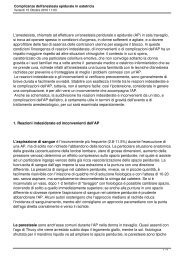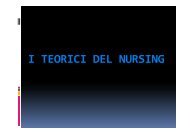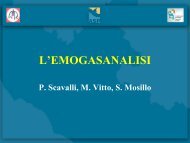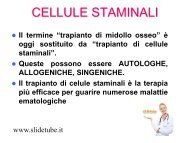Download - Slidetube.it
Download - Slidetube.it
Download - Slidetube.it
Create successful ePaper yourself
Turn your PDF publications into a flip-book with our unique Google optimized e-Paper software.
Nutrizionali<br />
Percorsi Assistenziali Neonatologici Anno 2008<br />
202<br />
66. NUTRIZIONE POST-DIMISSIONE<br />
Background<br />
I neonati prematuri, specie quelli con PN < 1500 grammi, al momento della dimissione<br />
possono aver accumulato un r<strong>it</strong>ardo di cresc<strong>it</strong>a paragonabile a quello dei soggetti IUGR<br />
in utero. Il recupero di tale defic<strong>it</strong> di accrescimento richiede tempo ed interventi<br />
alimentari adeguati, ad iniziare dall’utilizzo di formule a maggiore concentrazione<br />
calorico-proteica.<br />
Programmazione nutrizionale<br />
Formula per neonati a termine<br />
EG > 34 settimane<br />
Formula per neonati pretermine (fino a 42 settimane postmestruali)<br />
EG < 34 settimane alla dimissione<br />
Displasia broncopolmonare<br />
Osteopenia<br />
Formula post-dimissione (Post Discharge Formula) (fino a 9 mesi di età corretta)<br />
Peso < 3 centile<br />
Displasia broncopolmonare<br />
Osteopenia<br />
Latte Materno<br />
Se disponibile e sufficiente, può essere la sola alimentazione dopo la dimissione in<br />
presenza di tutti e 3 i seguenti requis<strong>it</strong>i al momento della dimissione:<br />
Capac<strong>it</strong>à di assumere > 180 ml/kg<br />
Veloc<strong>it</strong>à di cresc<strong>it</strong>a nella norma<br />
(Peso > 20 g/die, Lunghezza e CC > 0,5 cm/sett)<br />
Parametri biochimici nella norma<br />
(Az.ureico > 5 mg/dl, Fosfatasi Alcalina < 450 UI/l, Fosforo > 5 mg/dl)<br />
In caso contrario è da programmare un’integrazione con formula (come da schema<br />
precedente) la cui quant<strong>it</strong>à e durata dovrà essere individualizzata in funzione dei<br />
parametri di cresc<strong>it</strong>a e di laboratorio (vedi Protocollo Follow-up)<br />
<br />
1. Carver JD, Wu PY, Hall RT, Ziegler EE, Sosa R, Jacobs J et al. Growth of preterm infants fed nutrient-enriched or term<br />
formula after hosp<strong>it</strong>al discharge. Pediatrics 2001;107:683-689.<br />
2. Cooke RJ, Embleton ND, Griffin IJ, Wells JC, McCormick KP. Feeding preterm infants after hosp<strong>it</strong>al discharge: growth and<br />
development at 18 months of age. Pediatr Res 2001 ;49:719722.<br />
3. Cooke RJ, Griffin IJ, McCormick K, Wells JC, Sm<strong>it</strong>h JS, Robinson SJ, Leighton M. Feeding preterm infants after hosp<strong>it</strong>al<br />
discharge: effect of dietary manipulation on nutrient intake and growth. Pediatr Res 1998;43:355-360.<br />
4. Cooke RJ, McCormick K, Griffin IJ, Embleton N, Faulkner K, Wells JC, Rawlings DC. Feeding preterm infants after hosp<strong>it</strong>al<br />
discharge: effect of diet on body compos<strong>it</strong>ion. Pediatr Res 1999;46:461-464.<br />
5. De Curtis M, Pieltain C, Rigo J. Body compos<strong>it</strong>ion in preterm infants fed standard term or enriched formula after hosp<strong>it</strong>al<br />
discharge. Eur J Nutr 2002;41:177-182.<br />
6. Lucas A, Fewtrell MS, Morley R, Singhal A, Abbott RA, Isaacs E et al. Randomized trial of nutrient-enriched formula versus<br />
standard formula for postdischarge preterm infants. Pediatrics 2001;108:703-711.

















